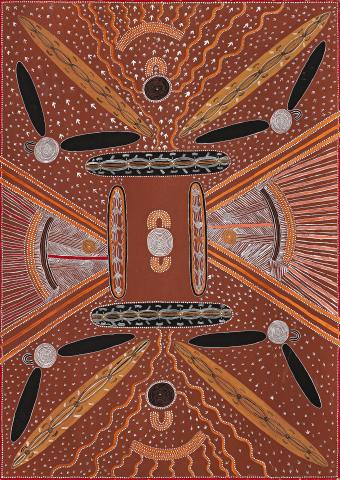BUDGERIGAR DREAMING (VERSION 6), 1972
KAAPA TJAMPITJINPA
synthetic polymer powder paint on composition board
91.5 x 65.0 cm
signed verso: KOAAAP [sic]
Painted at Papunya in June 1972
The W.L. Jackson Collection of Early Western Desert Paintings, Victoria
Sotheby's, Melbourne, 28 June 1999, lot 69
Private collection, Victoria
Sotheby's, Melbourne, 31 July 2006, lot 81
The Luczo Family Collection, USA
On long-term loan to the Art Gallery of South Australia, Adelaide from March 2007 to late 2015 and exhibited in the Collection Galleries, Art Gallery of South Australia, 27 March 2007 – 27 August 2010
Tjukurrtjanu: Origins of Western Desert Art, National Gallery of Victoria, Melbourne, 30 September 2011 – 12 February 2012; Musée du Quai Branly, Paris, 9 October 2012 – 20 January 2013 (label attached verso)
Big Country, Art Gallery of South Australia, Adelaide, 31 August 2013 – 19 January 2014
Bardon, G., Papunya Tula, Art of the Western Desert, McPhee Gribble, Melbourne, 1991, p. 111 (illus.)
Bardon, G. and Bardon, J., Papunya, A Place Made After the Story: The Beginnings of the Western Desert Painting Movement, The Miegunyah Press, Melbourne, 2004, painting 216, p. 280, and a photograph showing the artist painting this work is reproduced on p. 278.
Kaapa Tjampitjinpa was the most influential artist working at Papunya in the early 1970s. Bardon regarded him ‘as a man of fabulous brilliance, a classically compulsive artist’. His authority and expertise was also recognised by senior custodians who charged him with the responsibility of being ‘principal artist’ for the Honey Ant Mural at the Papunya School.1 As a result of his preeminence, Kaapa was able to secure larger boards and better brushes than his peers; moreover his priority ensured that he was paid significantly more for his work than other artists. Budgerigar Dreaming (Version 6), 1972 is a consummate example of the first phase of Kaapa’s artistic achievement.
Kaapa did not have a compliant nature. He railed under the controlling mantle of government’s policy of assimilation and was dismissed as a ‘troublemaker’. He came to the attention of authorities precisely because he sought to forge a new direction, based on an assumption of his equality and entitlement. A canny entrepreneur, Kaapa’s insouciance was in stark contrast to the governing expectation that the Indigenous residents of Papunya should submit to an extended ‘traineeship’ under European supervision. His independent spirit found abundant expression in revolutionary visual form. Kaapa is now rightly recognized as the founder, and first master of the contemporary Aboriginal art movement in Central Australia.2
Kaapa grew up at Napperby, in Anmatyerr country, with his Anmatyerr cousins, Tim Leura, Clifford Possum and Bill Stockman. As a young man, he worked as a stockman on stations across Central Australia, droving cattle as far as Mt Isa, Queensland.
Kaapa and his cousins shared familial relationships with Western Arrernte families based at Hermannsburg Mission, and were well aware of the income and notoriety generated by Albert Namatjira, the most famous individual in the Centre. Kaapa also aspired to become an artist.
By the spring of 1971, Kaapa had abandoned the use of perspective, instead he set out on a program of formal experimentation. Often working in association with Leura, the cousins pioneered an analytical planar view, through which they strived to achieve perfectly balanced arrangements of ceremonial objects and icons within a governing rectangular format. Bardon regards the current work as Kaapa’s ‘ultimate achievement’.3 and it is certainly the most exquisitely resolved of a series of ten Budgerigar Dreaming boards he painted in the winter of 1972.
Kaapa’s meticulous experiments mirror the mathematical exertions of Euclid, and the artists of classical antiquity, who determined to manifest the ‘golden ratio’. The divine geometry of Kaapa’s Budgerigar Dreaming is derived from the equilibrium established between an understated centerline, around which objects are dynamically displaced. The center of the composition remains unadorned, apart from a customary motif, representing two ancestors adjacent to a ground design evoked by a perfectly executed set of concentric circles. Governed by the principal of diametric symmetry, adjacent panels are animated with objects and signs associated with the celebration of Atetherr (Budgerigar) ancestors. Sacred objects that had previously been expressed in graphic detail are refined to become sets of lines, which indicate the material presence of the objects, without disclosing details of their construction.
The whole composition is anchored with attenuated (yellow ochre) oval objects, radiating diagonally towards each corner. The tiny white arrows, shown ‘flying’ toward the ceremonial ground indicate the ‘tracks’ of Atetherr. They evoke vast flocks of Budgerigars that congregate at water places across arid Australia. Not only do the traces of the Atetherr refer to frequently observed natural phenomena, but they also prompt an analogy between the massing birds and the eagerness of post-initiate men who congregate on the ceremonial ground, thirsty for the knowledge of the elders.
The compositional template on which Budgerigar Dreaming is based exerted a significant influence on Kaapa’s peers. Moreover his use of Atetherr ‘tracks’to animate the background, prefigure the emergence of a dotted infill, that, in the later part of 1972, would become a dominant feature of Papunya painting. Budgerigar Dreaming (Version 6), 1972 is a critical work in the history of desert art, for not only does it encapsulate a period of vibrant experimentation but also forecasts key attributes that would come to define Papunya Tula painting.
JOHN KEAN
1. Bardon, G. and Bardon, J., Papunya: A Place Made After the Story: The Beginnings of the Western Desert Painting Movement, TheMiegunyah Press, Melbourne, 2004, pp. 12 – 19
2. Johnson, V., Once Upon a Time in Papunya, University of New South Wales Press, Sydney, 2010, pp. 11 – 43
3. Bardon, G. and Bardon, J., Papunya: A Place Made After the Story: The Beginnings of the Western Desert Painting Movement, TheMiegunyah Press, Melbourne, 2004, p. 280
